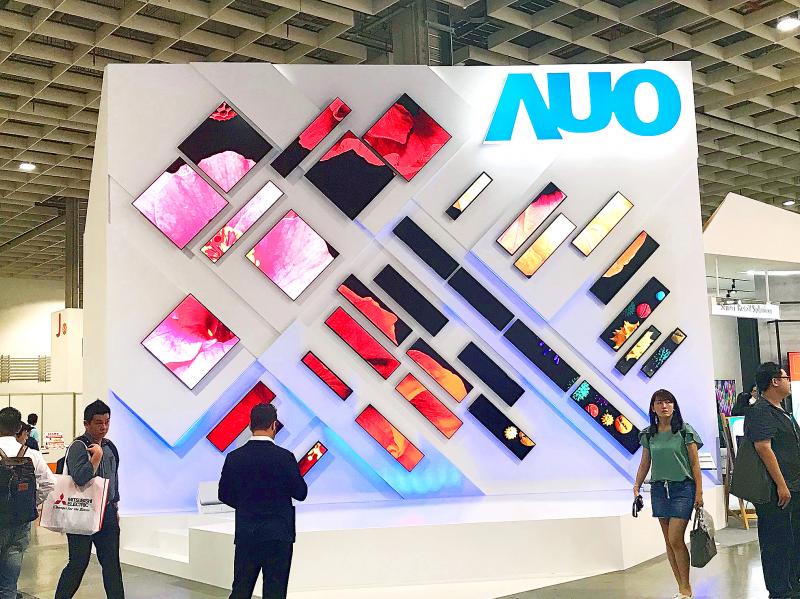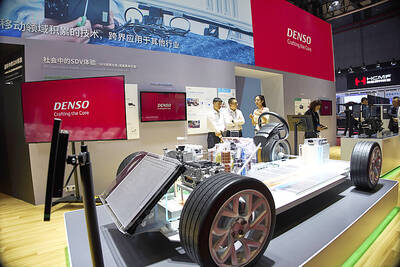LCD panel maker AU Optronics Corp (AUO, 友達光電) returned a profit in the third quarter — the first quarter in eight — as demand boosted by the COVID-19 pandemic drove shipments of large TVs and notebook computers.
The stay-at-home, work-from-home and distance-learning trends helped the Hsinchu-based company make NT$2.89 billion (US$99.95 million) in net profit last quarter, reversing a loss of NT$2.96 billion in the second quarter and a loss of NT$3.99 billion in the third quarter last year.
That translated into earnings per share of NT$0.3, versus minus-NT$0.31 a quarter earlier and minus-NT$0.41 a year earlier.

Photo: Chen Mei-ying, Taipei Times
The firm expects the uptrend to extend into this quarter and even to “overflow” into the first half of next year, as a resurgence of the pandemic hits many countries, further supporting the stay-at-home economy.
The prices of TV and PC panels this quarter are expected to increase by 8 to 9 percent quarterly, following an uptick of 8.82 percent in the blended average selling price to US$333 per unit last quarter, it said.
While unit shipments are expected to slide, factory utilization should remain high, similar to last quarter’s 95 percent, it added.
“The industry’s seasonal cycles this year have been upended by the pandemic,” AUO chairman Paul Peng (彭双浪) told investors yesterday. “We think the first quarter will be a trough, as we expected. Operations will improve quarter by quarter in the remainder of this year.”
On the demand front, the company sees the stay-at-home economy continuing to drive robust demand in the fourth quarter, Peng said.
Remote schooling has prompted strong demand for Chromebooks, he said, adding that the company has accumulated a large backlog of orders for Chromebook panels.
Global sales of TV sets last quarter rose about 11 percent from a year earlier, beating the market’s expectation of 3 percent growth, AUO said.
Notebook computer shipments last quarter rose 35 percent and whole-year shipments are likely to register double-digit percentage growth, the company said.
On the supply side, new capacity expansion in China has slowed, as the government slashed subsidies and allocated more resources to support semiconductor technology development in the wake of the US-China trade dispute, Peng said.
Tight component supply is a major concern, he said, adding that the company is also closely monitoring the economic fallout of geopolitical tensions and the pandemic.
AUO holds a positive outlook for the industry long term, with it likely to move toward healthy, market-oriented development over the next few years in the absence of intervention by the Chinese government, Peng said.
The company said that it expects capital spending this year to reach about NT$20 billion.
Yesterday, Innolux Corp (群創) reported that it also swung into the black last quarter with a net profit of NT$1.54 billion, or NT$0.16 per share, compared with a loss of NT$4.78 billion in the second quarter.
The company posted a net loss of NT$3.89 billion in the third quarter last year.
Innolux holds a positive outlook for this quarter, expecting shipments of large panels to drop about 5 percent from last quarter, while the average selling price is expected to rise by 8 to 9 percent from last quarter.

GROWING OWINGS: While Luxembourg and China swapped the top three spots, the US continued to be the largest exposure for Taiwan for the 41st consecutive quarter The US remained the largest debtor nation to Taiwan’s banking sector for the 41st consecutive quarter at the end of September, after local banks’ exposure to the US market rose more than 2 percent from three months earlier, the central bank said. Exposure to the US increased to US$198.896 billion, up US$4.026 billion, or 2.07 percent, from US$194.87 billion in the previous quarter, data released by the central bank showed on Friday. Of the increase, about US$1.4 billion came from banks’ investments in securitized products and interbank loans in the US, while another US$2.6 billion stemmed from trust assets, including mutual funds,

AI TALENT: No financial details were released about the deal, in which top Groq executives, including its CEO, would join Nvidia to help advance the technology Nvidia Corp has agreed to a licensing deal with artificial intelligence (AI) start-up Groq, furthering its investments in companies connected to the AI boom and gaining the right to add a new type of technology to its products. The world’s largest publicly traded company has paid for the right to use Groq’s technology and is to integrate its chip design into future products. Some of the start-up’s executives are leaving to join Nvidia to help with that effort, the companies said. Groq would continue as an independent company with a new chief executive, it said on Wednesday in a post on its Web

JOINT EFFORTS: MediaTek would partner with Denso to develop custom chips to support the car-part specialist company’s driver-assist systems in an expanding market MediaTek Inc (聯發科), the world’s largest mobile phone chip designer, yesterday said it is working closely with Japan’s Denso Corp to build a custom automotive system-on-chip (SoC) solution tailored for advanced driver-assistance systems and cockpit systems, adding another customer to its new application-specific IC (ASIC) business. This effort merges Denso’s automotive-grade safety expertise and deep vehicle integration with MediaTek’s technologies cultivated through the development of Media- Tek’s Dimensity AX, leveraging efficient, high-performance SoCs and artificial intelligence (AI) capabilities to offer a scalable, production-ready platform for next-generation driver assistance, the company said in a statement yesterday. “Through this collaboration, we are bringing two

Even as the US is embarked on a bitter rivalry with China over the deployment of artificial intelligence (AI), Chinese technology is quietly making inroads into the US market. Despite considerable geopolitical tensions, Chinese open-source AI models are winning over a growing number of programmers and companies in the US. These are different from the closed generative AI models that have become household names — ChatGPT-maker OpenAI or Google’s Gemini — whose inner workings are fiercely protected. In contrast, “open” models offered by many Chinese rivals, from Alibaba (阿里巴巴) to DeepSeek (深度求索), allow programmers to customize parts of the software to suit their